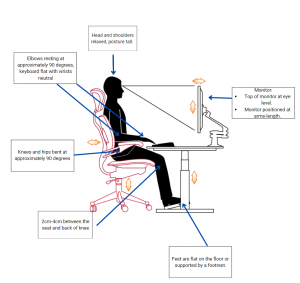(over the next few weeks we will also send you a short 10-minute exercise program to help)
- Sit in a neutral spine
- Keep your elbows tucked in close to the body and bent between 90-110 degrees
- Place your feet flat on the floor, if needed on a small step or incline
- Your chair should support the lower back and upper back to promote a neutral spine, you can also try and use a rolled-up towel in your lower back for extra support if you haven’t got an ergonomic chair
- Keep knees in line with hips and feet slightly placed past your knees
Desk, Chair, Computer Screen Setup
After adjusting your sitting posture it is critical to look at the structural setup of your workstation
- Adjust work surfaces such as desks or dining tables allowing you to be upright
- Lift or lower chair to ensure the correct sitting height in relation to your workstation
- Adjust the armrest so it does not get caught on the desk
- Position your screen directly vertical to your line of sight and make sure there is no glare. Also, try to avoid working into direct light behind your screen.
- Try to separate the keyboard and mouse to ensure you are not overreaching to type or manoeuvre your mouse
A few extra tips:
- Be sure to select adequate font size and brightness to stop poking your head forward towards the screen or squint your eyes
- Try to regularly stand up, go for short walks, or march on the spot if you are using a standing desk
-
- Use an alarm or other reminders like post-it notes, regular phone calls or email conversations, to remind yourself to take a break and do some exercises or stretches if you are the type of worker to forget.
- Use an alarm or other reminders like post-it notes, regular phone calls or email conversations, to remind yourself to take a break and do some exercises or stretches if you are the type of worker to forget.
-
Impacts of Prolonged Sitting
Typically, the human body is designed to function in an upright position therefore prolonged periods of sitting down can contribute to the development of various health issues.
Short Term Impacts
- Weight Gain, as your digestive system is less efficient when you are sedentary
- Weakening of your legs and gluteal muscles
- Problems with your hip joint
- Lower back pain
- Poor posture
- Stiffness in your neck and shoulders
- Links to depression and anxiety
Long Term Impacts
- Increases risk of heart disease
- Linked to diabetes
- Increase the risk of Varicose veins
- Potential Deep vein thrombosis
Next week we will provide you with a few more exercises you can do to help avoid these issues.



